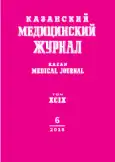Эффективность современных методов коррекции синдрома гиперандрогении яичникового генеза в период полового созревания
- Авторы: Алиева Э.М.1, Ахундова Н.Э.1
-
Учреждения:
- Азербайджанский медицинский университет
- Выпуск: Том 99, № 6 (2018)
- Страницы: 931-935
- Тип: Теоретическая и клиническая медицина
- URL: https://bakhtiniada.ru/kazanmedj/article/view/10508
- DOI: https://doi.org/10.17816/KMJ2018-931
- ID: 10508
Цитировать
Полный текст
Аннотация
Цель. Оценить эффективность коррекции синдрома гиперандрогении яичникового генеза (ГАЯГ) у девочек в период полового созревания.
Методы. Были обследованы 38 девочек с синдромом ГАЯГ. Средний возраст девочек составил 14,39 ± 0,27 лет. Гирсутное число по шкале Ферримана - Голлвея составило 19,7 ± 0,47 баллов, гормональное число - 18,14 ± 2,43 баллов, индифферентное число - 2,34 ± 0,13 баллов. Группу сравнения составили 20 девочек соответствующего возраста (14,74 ± 0,15 лет) с физиологическим течением пубертата. Исследование включало определение выраженности гирсутизма по шкале Ферримана - Голлвея, исследование уровня гормонов гипоталамо-гипофизарно-надпочечниково-яичниковой системы в раннюю фолликулярную фазу на 5-7 день менструального цикла.
Результаты. Установлено, что причинами синдрома ГАЯГ в пубертатном периоде были синдром поликистозных яичников (СПКЯ) у 68,42 % и опухолевидные образования (фолликулярные кисты) яичников у 31,58 %. У девочек с синдромом ГАЯГ в сравнении со здоровыми девочками выявлены статистически достоверные высокие показатели лютеинизирующего гормона (ЛГ) - 9,19 ± 0,96 мМЕ/мл, соотношения ЛГ/ФСГ - 1,8 ± 0,15, общего тестостерона (Тобщ.) - 1,3 ± 0,11 нг/мл, эстрона (Э1) - 109,5 ± 4,88 нг/мл, андростендиона (Ан) - 4,01 ± 0,12 нг/мл, а также низкие показатели эстрадиола (Э2) - 49,1 ± 2,6 пг/мл и связывающего половой гормон глобулина (СПГГ) - 45,7 ± 2,14 нмоль/л. Исследование показало, что на фоне коррекции синдрома гиперандрогении у пациенток отмечалось увеличение уровня Э2, СПГГ и снижение уровня ЛГ, соотношения ЛГ/ФСГ, Тобщ., Ан.
Выводы. Комплексная патогенетическая терапия синдрома ГАЯГ у девочек в период полового созревания способствует значительному улучшению гормонального статуса у данного контингента больных.
Ключевые слова
Полный текст
Открыть статью на сайте журналаОб авторах
Эльмира Микаил гызы Алиева
Азербайджанский медицинский университет
Автор, ответственный за переписку.
Email: mic_amu@mail.ru
г. Баку, Азербайджан
Натаван Эльдар гызы Ахундова
Азербайджанский медицинский университет
Email: mic_amu@mail.ru
г. Баку, Азербайджан
Список литературы
- Волкова Н.И., Димитриаиди Т.А. Диагностика синдрома гиперандрогении в реальной практике (ретроспективный анализ). Фарматека. 2009; 17: 48-51.
- Рафиева З.Х., Абдурахманова Ф.М. Эндокринные нарушения у девушек, перенесших психоэмоциональный стресс. Всероссийский вестник акушера-гинеколога. 2009; 9 (4): 51-55.
- Yildiz B.O., Bolour S., Woods K., Moore A., Azziz R. Visualy scoring hirsutism. Hum. Reprod. Update. 2010; 16 (1): 51-64. doi: 10.1093/humupd/dmp024.
- Amalfi S., Velez L.M., Heber M.F. Prenatal hyperandrogenization induces metabolic and endocrine alterations which depends on the level of testosterone exposure. PloS One. 2012; 7 (5): 37658. doi: 10.1371/journal.pone.0037658.
- Aminzadeh M., Kim H.G., Layman L.C. Rarer syndromes characterized by hypogonadotropic hypogonadism. Front. Horm. Res. Basel, Karger. 2010; 39: 154-167. doi: 10.1159/000312701.
- Bals-Pratsch M., Seifert B., Ortmann O. Genetic Causes in Adrenal or Ovarian Hyperandrogenism in the Reproductive Years. Am. J. Reproduktionsmed. Endokrinol. 2009; 6 (1): 19-23.
- Carmina E., Oberfield S., Lobo R. The diagnosis of polycystic ovary syndrome in adolescents. Am. J. Obstet. Gynecol. 2010; 203: 1-5. doi: 10.1016/j.ajog.2010.03.008.
- Панарина О.В., Рашидова М.А., Беленькая Л.В., Трофимова Т.А., Шолохов Л.Ф. Современные представления о патогенезе синдрома поликистозных яичников (обзор литературы). Acta Biomedica Scientifica. 2017; 2 (4): 9-14. . doi: 10.12737/article_59fad50f053c20.99807656.
- Hickey M., Sloboda D.M., Atkison N.C. The relationship between maternal and umbilical cord androgen levels and polycystic ovary syndrome in adolescence. J. Clin. Endocrinol. Metab. 2009; 94 (10): 3714-3720. doi: 10.1210/jc.2009-0544.
- Zachurzok A., Deja G., Gawlik A., Drosdzol-Cop A. Hyperandrogenism in adolescent girls with type 1 diabetes mellitus treated with intensive and continuous subcutaneous insulin therapy. Endokrinol. Pol. 2013; 64 (2): 121-128. PMID: 23653275.
- Nafiye Y., Sevtap K., Muammer D., et al. The effect of serum and intrafollicular insulin resistance parameters and homocysteine levels of nonobese, nonhyperandrogenemic polycystic ovary syndrome patients on in vitro fertilization outcome. Fertil. Steril. 2010; 93 (6): 1864-1869. doi: 10.1016/j.fertnstert.2008.12.024.
Дополнительные файлы






